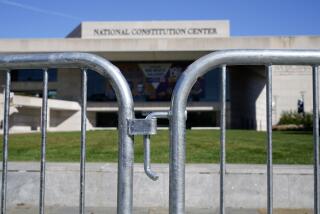A False God Called Arms Control : Ceremonies of Reassurance Are Misread as Key to U.S. Security
- Share via
There is an ironic logic to the visits of Pope John Paul II and Soviet Minister Eduard A. Shevardnadze to the United States taking place at the same time. Both visits make Americans feel good, both appeal to most of the basic human sentiments, and both contain a hope of salvation.
In the Pope’s case we are honest with ourselves. We know that his message is religious in nature, and treat it as such.
As far as the mission of the foreign minister is concerned, clarity of thinking is not with us. We have managed to persuade ourselves that substantive matters crucial to the survival of mankind are at stake. Instead, all we are offered is another experience in a secular religion called arms control. We may love it or hate it, but what does it have to do with the real causes of superpower friction?
Make no mistake--while the Reagan Administration will engage Shevardnadze in talks about matters beyond arms control, nothing of importance will come out of them. Customs of the American political process and requirements of diplomatic pretense, particularly vis-a-vis friends and allies of the United States, oblige the President and his advisers to make brave announcements regarding the placing of human rights and regional disputes on the top of the U.S.-Soviet negotiating agenda. But Administration insiders are well aware that it is only in the arms-control area that Washington and Moscow have a prospect of cutting a major deal. And if the Kremlin and the White House are determined to create an impression of a momentum of peace, it is to arms control that they are bound to turn.
And what is wrong with a vigorous pursuit of arms control? Nothing, in principle. In the era of nuclear overkill it is only civilized for the United States and the Soviet Union to talk about keeping the doomsday potential that they created together well under control. The trouble starts when this functional equivalent of smoking a peace pipe becomes the centerpiece of the superpower relationship, when what is essentially a reassuring ceremony begins to be treated almost as the ultimate solution to the American national-security dilemma.
Such an attitude is dangerous to the extent that its ritualistic dimension is allowed to obscure the real causes of superpower rivalry--like the incompatible global ambitions of two visionary nations and the conflicting economic interests of the United States, which exports manufactured goods and agricultural products, and of the Soviet Union, which imports them, paying with its raw materials, principally oil. In terms of world trade, America belongs to the North and Russia to the South. The antagonism is enhanced by contrasting values and diverging political structures. Arms control does not and cannot address these fundamental roots of the superpower hostility. Instead, it contains a promise of salvation through a ceremony of destruction of some tools of war. But it takes a religious rather than an analytical approach to believe that the elimination of a relatively small number of weapons, whether bows and arrows or warheads and launchers, can make the world a much safer place.
The emerging agreement on the elimination of intermediate-range nuclear weapons will, at best, lead to the destruction of fewer than 2,000 out of the existing 50,000 nuclear warheads. This 4% solution will of course be labeled by both sides as a historic accomplishment.
The deal offers practically no hope of either reconciling U.S.-Soviet differences or reducing their arsenals to a point where they could not wage a mutually suicidal war. And it is precisely the military insignificance of intermediate-range forces that has allowed the sides to demonstrate flexibility at the bargaining table. Any agreement that would go beyond numerical reductions in an attempt to make a real difference in strategic stability for both sides appears at this juncture to be completely beyond reach.
And here lies the distinction between religious and analytical thinking. If something--even something highly desirable--is unattainable, analytical thinking accepts the inevitable and tries to deal with the consequences. Religious thinking, on the other hand, confronts facts with faith and finds satisfaction in rituals designed to serve as symbolic substitutes for unavailable solutions.
Practical politicians know the simple rule: Never meddle with faith. Accordingly, it was a major mistake for the Administration to provoke the arms-control faithful with an exuberant militarist rhetoric. Unfortunately, history does not permit conducting an experiment. So we are never going to be sure whether the present overemphasis on arms control could be avoided if the President, at the outset of his tenure, had communicated his arms-control commitment more persuasively. Maybe a benign downgrading of arms control could work where the provocative neglect originally practiced by the Reagan crowd had produced a strong backlash.
Arms-control euphoria is back. But if the history of U.S.-Soviet relations is any guide, it will not last for long. People enjoy having faith, but living by it is a different matter. Somewhere, somehow, something is bound to happen between the United States and the Soviet Union that would remind us again that there is no escape from the nasty rules of traditional power politics. Bet on it.
More to Read
Sign up for Essential California
The most important California stories and recommendations in your inbox every morning.
You may occasionally receive promotional content from the Los Angeles Times.













